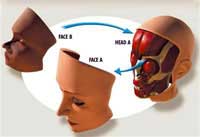 Liver transplants, kidney transplants, and even hand transplants—complex surgeries like these have become commonplace. But what about face transplants? Imagine a patient receiving a nose, mouth, or even an entire face from someone who has died. Controversy has erupted, yet a face transplant has recently been successfully completed in France.
Liver transplants, kidney transplants, and even hand transplants—complex surgeries like these have become commonplace. But what about face transplants? Imagine a patient receiving a nose, mouth, or even an entire face from someone who has died. Controversy has erupted, yet a face transplant has recently been successfully completed in France.
Nose, Mouth, and Chin Transplant
This is the first face transplant in the world, concluding a quiet yet fierce competition among researchers from the United Kingdom, France, and the United States. The patient is a 38-year-old woman from Valenciennes in northern France. Last May, she suffered a horrific dog attack that shattered her face, resulting in the loss of her nose, lips, and chin. Since then, she has barely spoken or been able to chew. What tormented her the most was her disfigured appearance. After extensive discussions with a psychologist, she agreed to enter the operating room for this historic surgery.
All the tissues, muscles, arteries, veins, and skin required for the transplant were sourced from a brain-dead donor. This marks the first time in transplant history that skin has been taken from another person’s face rather than from the patient themselves. According to the doctors, the patient is in excellent health, and the transplant sites appear to be perfect. This news brings hope for a normal life to countless people living with facial deformities, such as severe burn victims.
Overwhelming Challenges
One of the biggest technical concerns during the transplant is whether the patient’s body will accept the newly “attached foreign objects.” Every two hours, doctors must check that blood circulation within the “foreign objects” is normal and that it integrates with the overall blood flow. Consequently, it is too early to declare the surgery a success. What will happen if it fails? What will the patient’s face look like then? These questions remain unpredictable at this stage, and the risks are substantial.
Experts also warn of the tendency for significant blood clotting in the newly grafted blood vessels, and immunosuppressive drugs may become ineffective. There is also an increased risk of cancer since the patient will need to take high doses of immunosuppressants for life.
Will She Look Exactly Like the Donor?
Not necessarily, as an individual’s facial features are determined not only by the shape of their eyes, nose, and mouth but also by their bone structure. Therefore, even in the case of a full face transplant, the patient cannot look exactly like the donor. Computer simulations have demonstrated this. However, it cannot be said that the patient’s face won’t resemble that of the donor, especially in cases of full face transplants. This presents the first obstacle leading to strong opposition against face transplants. Imagine the encounter between a grieving husband and another woman bearing the face of his deceased wife.
Additionally, there is another more difficult-to-accept obstacle. Imagine your loved one lying in a hospital’s intensive care unit. You would be the one to sign the consent form allowing doctors to remove your loved one’s face before taking them off life support. And it’s very possible that your loved one is still breathing. Face transplants can only be performed when the organs are harvested while the donor’s heart is still beating. For the recipient, it is also not easy to accept that they no longer resemble themselves but rather someone who has passed away.
Kiều Oanh

















































